Many Body Versions

The Civic has been the backbone of Honda for years, so our choice for that model quickly surfaced. But yes, which of the eleven generations that have crossed our path since 1972 is the best choice here?
Honda’s first mass-produced car was the S500 in 1963. This coupe, only 3.30 meters short, had an all-aluminum, water-cooled four-cylinder in-line engine of only 531 cc, with two overhead camshafts, four carburetors and a crankshaft rotating in ball bearings. The block delivered 42 hp at 8,000 rpm, so the specific power comes out to 79 hp/liter. Even then!
The differential was mounted directly on the gearbox and drove two chains, each connected to a rear wheel. The chain guards functioned as swing arms and connected to struts with shock absorbers. Such a construction is only recognizable when you are familiar with motorcycle technology. Honda’s choice is understandable, because it had long been (since 1959) the largest motorcycle manufacturer in the world, and still is today. The S500 evolved via the S600 to the S800 and thus to a still minuscule sports car with suddenly a hefty 70 hp and a serious top speed of 170 km/h.
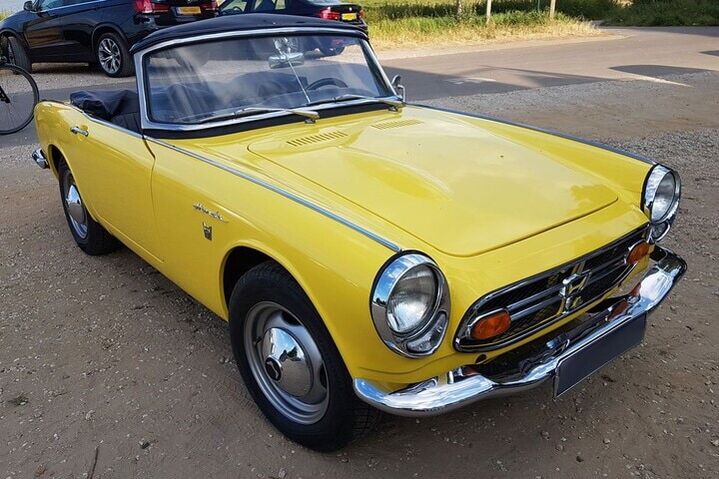
Although we consider it too exotic to embody the soul of Honda, we felt that this extensive technical description was appropriate as the beginning of this story; it indicates that no one with a penchant for high-quality automotive technology cannot also have a penchant for Honda. The nice thing in this context is that the Japanese manufacturer has always made its special technical constructions available to everyone as much as possible. The well-behaved sedans and SUVs that you would casually dismiss because of a deadly dose of boredom are usually technical gems at Honda. Typically cars for connoisseurs, who can do without outward appearances like a toothache and prefer to quietly enjoy the beauty that their seemingly commonplace sedan or family-friendly hatchback has to offer on their daily kilometers. We must certainly take this aspect into account for our search.
Honda was a Technical Pioneer
In the 1970s, when the import of Japanese cars to Europe got off to a good start, the tenor here was sometimes negative; perhaps out of fear of the unknown, or because of the alleged threat to the domestic industry, the Japanese brands were accused of an unstoppable urge to copy. Indeed, the conservative Toyotas and Datsuns of that time were easily comparable to what had already been built outside Japan. You could also see Japanese journalists at the press days of European car shows who exhaustively photographed new models and even attacked them in detail with a tape measure. In practice, however, the Japanese car manufacturers were just as much technical pioneers as the Europeans, something you can certainly say about Honda.

Civic was Honda’s First World Car
Take the Civic, Honda’s first world car. The original model from 1972 quickly made a big impression with its CVCC technology, which stands for a system that allowed the engine to function with a lean fuel mixture thanks to phased combustion. The exhaust gases were therefore clean enough to meet the strict emission requirements that came into effect in the United States in 1975 without further intervention. The Americans immediately embraced the Civic, also because there was an increasing demand for good compact and economical cars.
The small Honda was also popular because of its reasonably mature size. And thanks to independent suspension all around, it also had driving qualities that meant it could actually compete in a higher car class. The CVCC engine did not come to Europe, but the Civic itself quickly made friends here too, again thanks to that fine range of properties. It looked nice, delivered good performance, was pleasant to use and had reliable technology. Moreover, the Civic was available with an automatic transmission, the famous Hondamatic from its own factory, and that was a special feature in its price range.
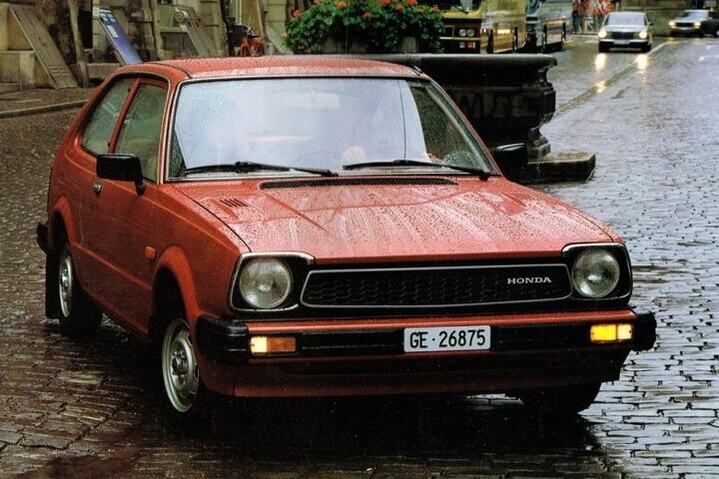
The successor from 1979 offered more of the same with a considerably larger body, but was otherwise not very spectacular. This generation only made a nice sidestep as a four-door sedan, which was not marketed as a Honda, but as a Triumph Acclaim. We would hear more about the collaboration with the British later. The third Civic generation, that of 1983, had much more up its sleeve. In fact, the entire automotive world was ahead of it.
Autumn 1983: The Third Civic
By 1983, Honda was already an established brand. In addition to the Civic, it also supplied the completely new Accord as a three-door hatchback and four-door sedan, the somewhat older five-door Quintet and the equally brand-new coupé Prelude. A neat range, which would receive a huge boost in the autumn with the introduction of the completely new Civic.

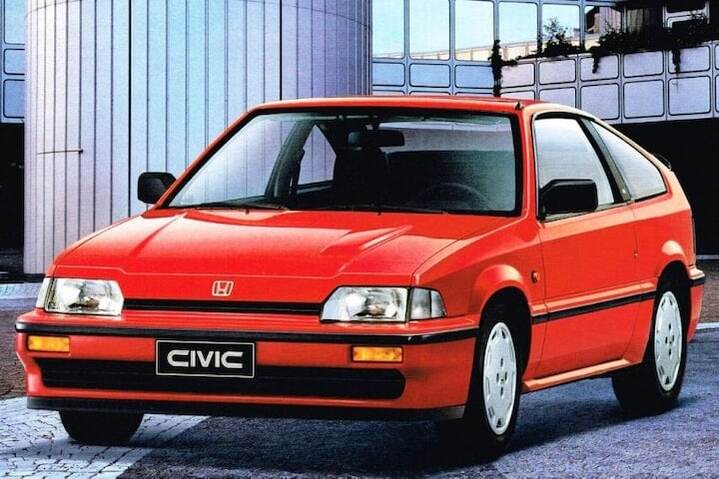
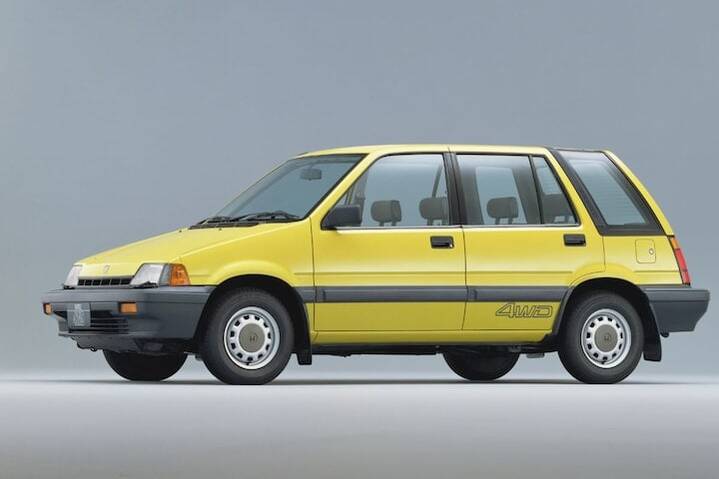
Honda Civic Shuttle
Three-by hatchback, CRX and Shuttle
That was a triple introduction: in addition to the three-door hatchback with the silhouette of a shooting brake, the Civic also appeared as the beautiful CRX coupe and as the innovative five-door Shuttle MPV. While car manufacturers nowadays have no problem quickly filling all kinds of niches between the well-known car segments, the joint arrival of no fewer than three remarkable, highly innovative models in what was then the most popular price class was nothing short of earth-shattering. The public debut was at the IAA in Frankfurt, where the new Hondas even paled public magnets such as the Porsche Gruppe B, the Audi Sport Quattro and a brand new Golf GTI. They were all as special as they were talked about. The exception was again the somewhat commonplace four-door sedan, which Honda therefore kept outside its own European range and cleverly passed on to the friends of Rover. That adopted him with love as 213/216.

How special was the new Civic trio? Well, in fact in everything. Building three models in this segment for three very different target groups had – as far as we can tell – not been shown before. A brand like Opel did something similar earlier by offering the C-Kadett as a sedan, station wagon, hatchback and coupe, but they were closely related in terms of appearance and technology. The Civics involved three very different concepts. A gamble of course, but the Honda seller could thus give an answer to many questions. Everyday dynamics? The smooth hatchback offered it in ample measure. Yes, it was a bit tight in the back, but for those who wanted more on that point there was the very spacious Shuttle, the compact MPV avant-la-lettre.
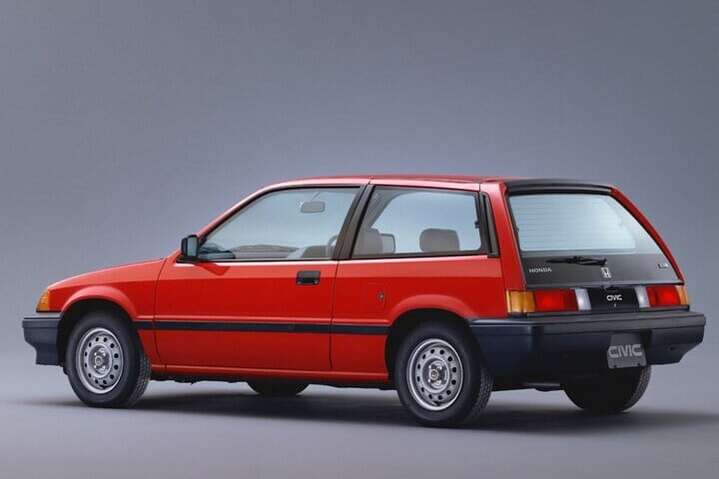
Pure sportiness or strolling along the boulevard? There was the CRX for that. It is strictly a two-seater (the sunroof moves outwards, because there is no space inside), but also a high-tech go-kart with 100 hp at 810 kilos – the thing easily runs 190 in the hour. All models received new engines with three valves per cylinder (and injection for the CRX) for impressive performance and low consumption, with the light construction and favorable aerodynamics also having a positive influence each time. Of course, the Shuttle scored the least high here, but this model had very different qualities, such as an unprecedented amount of space for its class. The later addition of four-wheel drive paved the way (almost literally) for the brand’s later SUVs.

Fourth Generation also as Sedan with Us
The third Civic generation has been decisive for the further evolution of this model series. The fourth generation (1987) comprised the same three models, this time with the addition of a sedan. With the fifth generation (1991), the Civic retained its continuous roof line, with a horizontally divided tailgate as a special feature. The CRX got its own career and no longer belonged to the Civic family. However, the sportiness was no less, as evidenced, for example, by the very fast and wild Type-Rs with which Honda immediately kept the fans of the hot hatchback on its side.
Furthermore, there were diesels, station wagons, hybrids and more. What remains is the pleasant thought that the Civic, in contrast to that other long-running model, the Accord, is still there. And also that the current model is primarily a car that focuses emphatically on the enthusiast. As far as we are concerned, that policy originated in 1983, with the groundbreaking generation of that time. The Honda that represents the soul of the brand like no other model of the brand.
– Backbone of Honda since 1972
– All-rounder, from city car to hp monster
– Always technically advanced
– Distinctive design
– Hatchback, coupé and MPV
These were also contenders for the ‘soul of honda’
In the boxes accompanying this story, we show the models that have also been reviewed during our deliberations, but which still had to lose out to that one winner.
S800
A true technical delicacy, whose small 791 cc small four-cylinder could run as much as 10,000 revolutions per minute. It was clearly faster with it than the then practically equally expensive Triumph Spitfire and MG Midget.
1300
Unknown makes unloved: the four-door Honda 1300 (1969-1972) was too inconspicuous for its brilliant technology. It had front-wheel drive and an air-cooled, 1.3-liter four-cylinder in-line engine with an overhead camshaft and up to 115 hp.
Accord
This was Honda’s second model in 1976, a car that was indispensable from the range for a long time. Always technically high-quality, but varying from pleasantly exotic (Aerodeck!) to unnecessarily bland over the years.
Prelude 4WS
The Prelude came on the market in 1978 as a compact two-door coupe based on the Accord. Our preference for this overview is the 1987 generation, because of the four-wheel steering with which Honda then had a world first (just before the Mazda 626).
NSX
In 1990, the NSX was Honda’s weapon to penetrate the part of the market where Ferrari and Porsche called the shots. A special feature was its easy handling, making it the best supercar to run errands with.
Insight (ZE1)
Honda’s first hybrid with the famous Integrated Motor Assist (IMA) was the small Insight, which appeared in 1999. IMA means an electric motor between the gasoline engine (here a 1.0-liter three-cylinder) and the transmission (a five-speed manual in the Insight).
S2000
To mark 50 years of Honda, the S2000 was released in 1999 as a tribute to the S models from the early years as a car manufacturer. You almost got dizzy from its engine technology: don’t shift at 7,000 rpm, but go through to 9,000 for 240 hp, that was the motto. Impressive.
CR-V
After the Toyota RAV4 had already smoothed the bumpy SUV path somewhat, Honda followed with the CR-V, which would prove to be a keeper as one of the few Hondas. Technically beautiful again, with independent suspension with double wishbones all around and a sturdy 16-valve under the hood.
E
A heartthrob with its comical retro appearance and the beautiful interior with the atmosphere of an intimate living room – complete with virtual aquarium. The range was small, the purchase price was high, but we are happy to step over such things. A must have!
FCX Clarity
The tangible proof of Honda’s belief in the hydrogen car. The FCX Clarity (2008-2014) had roughly the size, performance and ease of use of an Accord, but emitted only water vapor. The car was available in Europe, Japan and California via leasing.
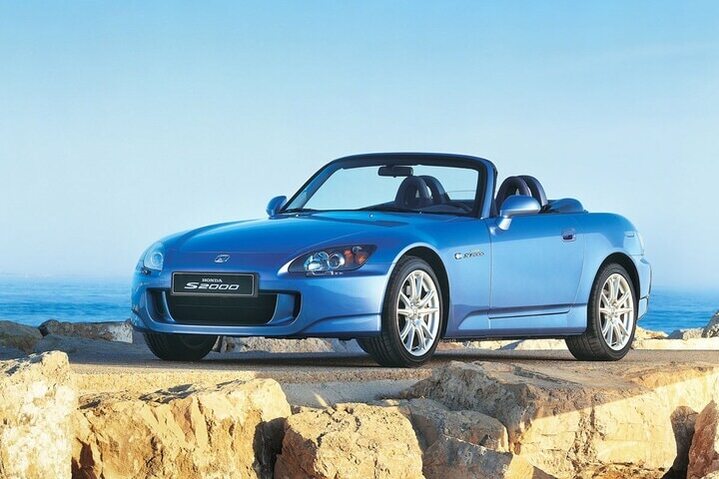
Passport Honda Civic
Body 3-door hatchback, 5-door MPV and 3-door coupé
Drive front wheels or 4WD (Shuttle)
Dimensions (LXWXH*): 3.81 x 3.99 x 3.67 / 1.64 x 1.65 x 1.62 / 1.34 x 1.49 x 1.29 m
Wheelbase*: 2.38/2.45/2.20 m
Weight 777 to 1,440 kg
Price Level (1984) from fl. 17,295/€ 7,848 (1.2 Special) to fl. 27,495/€ 12,477 (1.5i CRX)
Production Period 1983 to 1987
Production Number 1.3 million
Engines 1,187, 1,342, 1,488 and 1,590 cc (54, 70, 85/100 and 125 hp)
Competitors (1984) Ford Escort, Mazda 323, Mitsubishi Colt, Volkswagen Golf
*data Hatchback/Shuttle/CRX
Most Special
The topper among the Civics was the CRX 1.6i-16V from 1986. Its sixteen-valve with double overhead camshafts delivered 125 hp, good for 202 km/h and 0-100 in 8.1 seconds.
